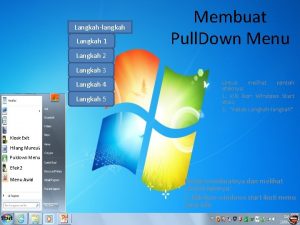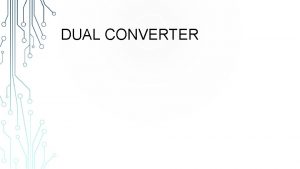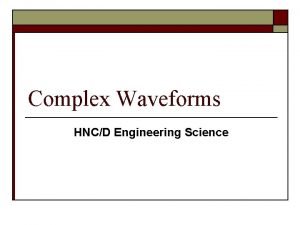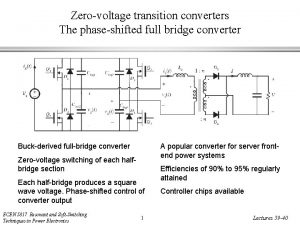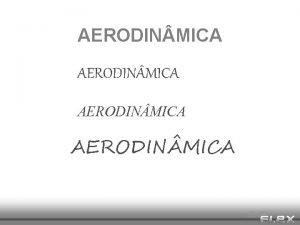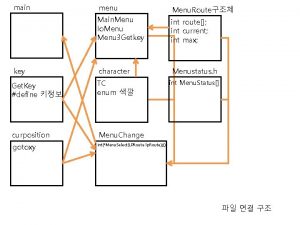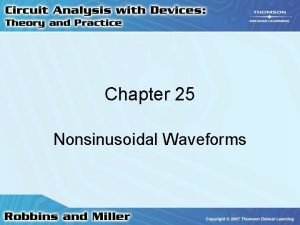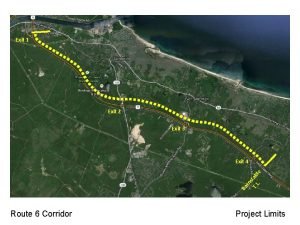Introduction to Waves and Waveforms Exit Main Menu














- Slides: 14

Introduction to Waves and Waveforms Exit

Main Menu http: //en. wikipedia. org/wiki/Image: Wave_packet. svg Exit What is a wave? Types of waves Waveforms Still to Come Citations About the author Concept map

What is a wave? A wave is the transmission of energy through space and time cause by a disturbance in space. Everyone has seen an example of this when you have wiggled an end of a string up and down. But, for those who might need an illustration, check out this website: http: //phet. colorado. edu/sims/string-wave/stringwave. swf. By wiggling the wrench up and down you create a disturbance. You then can see the energy from the disturbance transmitted along the string. Keep this illustration in mind, because it’s the big idea behind waves. Exit

Types of Waves There are three types of waves that physicists study. Click on the links below to learn more about each type. Mechanical Waves, Electromagnetic Waves, Matter Waves Exit

Waveforms Waves travel in two different forms: • Transverse waves are waves in which the energy that is transmitted oscillates perpendicular to the direction the wave is traveling. • Longitudinal waves are waves in which the energy that is transmitted oscillates parallel to the direction the wave is traveling. Learn More: transverse waves, longitudinal waves Exit

Still To Come • • • We’ve only just begun to talk about waves. Here are some things still to come: Parts of wave Frequency and wavelength Wave speed Superposition of waves Wave interference And more… Exit

Citations • Wave information verified from: Halliday, David, Robert Resnick, and Jearl Walker. Fundamentals of Physics. 7 th Ed, Wiley. Hoboken, NJ. 2005. • All pictures and videos (website cited with each) were downloaded on 6/10/08 • Electromagnetic waves video: Elements of Physics: Waves: Sound and Electromagnetism. United Learning. 2006. unitedstreaming. 10 June 2008 http: //streaming. discoveryeducation. com/ Exit

Concept Map Exit

Mechanical Waves Mechanical waves are the most familiar type of waves to us because they can be most readily seen in action. They also have the following properties: • • http: //en. wikipedia. org/wiki/Image: 2006 -01 -14_Surface_waves. jpg Mechanical waves must have a material to travel through (known as a medium). This can be water, air, dirt, basically anything made of matter. Mechanical waves are governed by Newton’s Laws. Water waves and sound waves are examples of mechanical waves. Back Exit

Electromagnetic Waves While waves of this type are not as easy to see in action as mechanical waves, we use them daily. Light travels as electromagnetic waves, and the common microwave oven uses electromagnetic waves to cook food. Electromagnetic waves differ from mechanical waves in that they require no medium to exist or travel. Back Exit • This link will take you to a video that explains electromagnetic waves in much more detail: EM Waves Video Clip http: //science. hq. nasa. gov/kids/imagers/ems/index. html

Electromagnetic Waves Video Clip Click on the movie to begin playback. Back Exit

Matter Waves Matter waves are a phenomenon studied in modern physics involving the oscillation of elementary particles in space. We will focus our attention on mechanical and electromagnetic waves and leave the study of matter waves for quantum mechanics. Back Exit

Transverse Waves • • • Back As was said previously, a transverse wave is one in which the direction of oscillation is perpendicular to the direction of wave motion. Think back to the wave-on-a-string applet you played with earlier. In that you could see that the disturbance was causing the string to move up and down while the disturbance itself was moving right to left. That is a transverse wave. Some examples of transverse waves are: wave on a string Water waves Light and all other EM waves Exit http: //www. pics 4 learning. com/details. php? img=p 1060311. jpg Almost all of us have even participated in a transverse wave. Don’t believe it? Check it out: http: //www. youtube. com/watch? v=c. PKGa 2 Ds. Is 0

Longitudinal Waves http: //en. wikipedia. org/wiki/Image: Budapest_Symphony_ Orchestra. jpg For another neat longitudinal wave example, check out: http: //www. teachertube. com/view_video. php? vie wkey=4806731 fdaa 64351 fa 7 a Back Exit Longitudinal waves are more difficult to explain because they are harder to see in everyday life. Their oscillations occur in the same direction as the wave is traveling. Sound is a common example of a longitudinal wave. With sound, a vibration pushes on the air molecules surrounding it, which in turn push on the air molecules surrounding them. This causes a chain reaction of vibrating molecules that will eventually reach the ear and be perceived as sound. To get a better visual of this, as well as a comparison between longitudinal and transverse waves, watch this video: http: //www. teachertube. com/view_video. p hp? viewkey=db 85 fc 94 ffa 4204146 aa
 1/3 diagonal rule egress
1/3 diagonal rule egress Exit exit access and exit discharge
Exit exit access and exit discharge Menu pull down exit terdapat pada menu
Menu pull down exit terdapat pada menu Compare and contrast p waves and s waves using venn diagram
Compare and contrast p waves and s waves using venn diagram Icp waveform a b c
Icp waveform a b c Calculate mean arterial pressure
Calculate mean arterial pressure Single phase dual converter waveforms
Single phase dual converter waveforms Ac waveforms
Ac waveforms Rapid interpretation of ventilator waveforms
Rapid interpretation of ventilator waveforms Complex waveforms
Complex waveforms Zero voltage switching waveforms
Zero voltage switching waveforms Do electromagnetic waves require a medium
Do electromagnetic waves require a medium An example for mechanical wave
An example for mechanical wave Mechanical waves and electromagnetic waves similarities
Mechanical waves and electromagnetic waves similarities Long waves and short waves
Long waves and short waves


